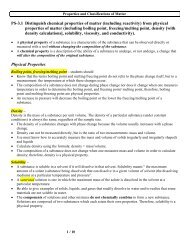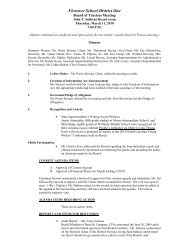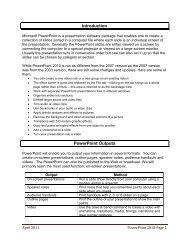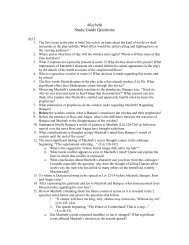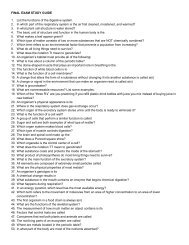Chapter 18 Notes
Chapter 18 Notes
Chapter 18 Notes
Create successful ePaper yourself
Turn your PDF publications into a flip-book with our unique Google optimized e-Paper software.
Display <strong>Chapter</strong> Features <strong>18</strong><br />
Visual Merchandising and Display<br />
• Section <strong>18</strong>.1 Display Features<br />
• Section <strong>18</strong>.2 Artistic Design
Display Features<br />
Key Terms<br />
visual<br />
merchandising<br />
display<br />
storefront<br />
marquee<br />
store layout<br />
fixtures<br />
point-ofpurchase<br />
displays<br />
(POPs)<br />
kiosk<br />
Objectives<br />
Explain the concept and purpose of visual<br />
merchandising<br />
Identify the elements of visual merchandising<br />
Describe types of display arrangements<br />
Understand the role of visual merchandisers on<br />
the marketing team<br />
Marketing Essentials <strong>Chapter</strong> <strong>18</strong>, Section <strong>18</strong>.1
Visual Merchandising and Display<br />
visual<br />
merchandising<br />
Coordinating the<br />
physical<br />
elements in a<br />
place of business<br />
to project the<br />
right image to<br />
customers.<br />
Visual merchandising X<br />
encompasses all of the physical<br />
elements that merchandisers use to<br />
project an image to customers.<br />
Visual merchandising:<br />
• Promotes interest in<br />
merchandise or services<br />
• Encourages purchasing<br />
• Reinforces customer<br />
satisfaction<br />
Marketing Essentials <strong>Chapter</strong> <strong>18</strong>, Section <strong>18</strong>.1
Visual Merchandising and Display<br />
display<br />
The visual and<br />
artistic aspects<br />
of presenting a<br />
product to a<br />
target group of<br />
customers.<br />
Display X refers to the visual and<br />
artistic aspects of presenting a<br />
product to a target group of<br />
customers. Visual merchandising,<br />
by contrast, encompasses the<br />
visual and artistic aspects of the<br />
entire business environment.<br />
Marketing Essentials <strong>Chapter</strong> <strong>18</strong>, Section <strong>18</strong>.1
Elements of Visual Merchandising<br />
Merchandisers consider four<br />
elements key to achieving the<br />
goal of creating a positive<br />
shopping experience for<br />
consumers:<br />
• Storefront<br />
• Store layout<br />
• Store interior<br />
• Interior displays<br />
Marketing Essentials <strong>Chapter</strong> <strong>18</strong>, Section <strong>18</strong>.1
Storefront<br />
storefront<br />
The exterior of a<br />
business that<br />
includes a store’s<br />
sign or logo,<br />
marquee,<br />
outdoor lighting,<br />
banners,<br />
planters,<br />
awnings,<br />
windows, the<br />
exterior design,<br />
ambiance,<br />
landscaping, and<br />
lighting of the<br />
building.<br />
The storefront X encompasses a store’s:<br />
• Sign or logo<br />
• Marquee<br />
• Banners<br />
• Windows<br />
• Exterior design, ambiance, and<br />
landscaping<br />
The design of a sign should be original and<br />
easily recognizable. The name, letters, logo,<br />
and colors help create the store’s desired image.<br />
Marketing Essentials <strong>Chapter</strong> <strong>18</strong>, Section <strong>18</strong>.1
Storefront<br />
A marquee is an architectural<br />
canopy that extends over a<br />
store’s entrance. Entrances are<br />
usually designed with customer<br />
convenience and store security in<br />
mind while window displays:<br />
• Initiate the selling process<br />
• Create excitement<br />
• Attract prospects<br />
Marketing Essentials <strong>Chapter</strong> <strong>18</strong>, Section <strong>18</strong>.1
Store Layout<br />
store layout<br />
The ways that<br />
stores use floor<br />
space to facilitate<br />
and promote<br />
sales and serve<br />
customers.<br />
Store layout X refers to ways that stores use<br />
floor space to facilitate and promote sales and<br />
serve customers. There are four distinct spaces:<br />
• Selling space: General interior of the store<br />
• Storage space: Stockrooms and inventory<br />
• Personnel space: Employee lockers and<br />
offices<br />
• Customer space: Areas of comfort and<br />
convenience for customers<br />
Store isles influence buying behavior more so than<br />
any other visual merchandising element!<br />
Marketing Essentials <strong>Chapter</strong> <strong>18</strong>, Section <strong>18</strong>.1
Store Interior<br />
Stores utilize visual merchandising tools such<br />
as:<br />
• Mannequins<br />
• Seating<br />
• Props<br />
• Floor and wall coverings<br />
• Lighting<br />
• Colors<br />
• Store fixtures<br />
• Interior signage<br />
• Graphics<br />
Marketing Essentials <strong>Chapter</strong> <strong>18</strong>, Section <strong>18</strong>.1
Store Interior<br />
Bright colors and light pastels appeal to<br />
different types of customers, while<br />
interior graphics and signs can be used<br />
to promote items or give directions.<br />
Walls can be covered to reinforce the<br />
store image or display merchandise.<br />
Marketing Essentials <strong>Chapter</strong> <strong>18</strong>, Section <strong>18</strong>.1
Store Interior<br />
fixtures<br />
The principal<br />
installations in a<br />
store; permanent<br />
or movable store<br />
furnishings that<br />
hold and display<br />
merchandise.<br />
The principal installations in a store are the<br />
fixtures X. Fixtures are permanent or<br />
movable store furnishings that hold and<br />
display merchandise. The basic types<br />
include:<br />
• Display cases<br />
• Tables<br />
• Counters<br />
• Floor and wall shelving units<br />
• Racks<br />
• Bins<br />
• Stands<br />
Marketing Essentials <strong>Chapter</strong> <strong>18</strong>, Section <strong>18</strong>.1
Interior Displays<br />
If interior displays are done<br />
exceptionally well, they enable<br />
customers to make a selection without<br />
the assistance of a sales clerk. Five<br />
types of interior displays are:<br />
• Closed displays<br />
• Open displays<br />
• Architectural displays<br />
• Point-of-purchase displays<br />
• Store decorations<br />
Marketing Essentials <strong>Chapter</strong> <strong>18</strong>, Section <strong>18</strong>.1
Interior Displays<br />
point-ofpurchase<br />
displays<br />
(POPs)<br />
A sales<br />
promotion<br />
device;<br />
manufactured<br />
units with bold<br />
graphics and<br />
signage that<br />
hold, display, or<br />
dispense<br />
products.<br />
Point-of-purchase displays (POPs)<br />
X are consumer sales promotion<br />
devices that hold, display, or dispense<br />
products. They promote impulse<br />
purchases. Examples include<br />
vending machines and racks<br />
holding candy at a checkout stand.<br />
Marketing Essentials <strong>Chapter</strong> <strong>18</strong>, Section <strong>18</strong>.1
Interior Displays<br />
kiosks<br />
Interactive pointof-purchase<br />
displays that are<br />
typically four feet<br />
high, have<br />
pedestalmounted<br />
hightech<br />
screens,<br />
and take up only<br />
a few square feet<br />
of floor space.<br />
Kiosks X are interactive point-ofpurchase<br />
or retail stands, such as<br />
photo-finishing stands for processing<br />
digital photos. They have become more<br />
popular because of:<br />
• Immediate product availability<br />
• More reliable technology<br />
• Information services<br />
Marketing Essentials <strong>Chapter</strong> <strong>18</strong>, Section <strong>18</strong>.1
Interior Displays<br />
Props, also called properties,<br />
are special display elements.<br />
They are generally classified<br />
as decorative or functional.<br />
Functional props, such as<br />
mannequins, hold<br />
merchandise.<br />
Marketing Essentials <strong>Chapter</strong> <strong>18</strong>, Section <strong>18</strong>.1
SECTION <strong>18</strong>.1 REVIEW
SECTION <strong>18</strong>.1 REVIEW<br />
- click twice to continue -
Artistic Design<br />
Key Terms<br />
color wheel<br />
complementary<br />
colors<br />
adjacent colors<br />
triadic colors<br />
focal point<br />
proportion<br />
formal balance<br />
informal<br />
balance<br />
Objectives<br />
List the five steps in creating a display<br />
Explain how artistic elements function in display<br />
design<br />
Describe the importance of display maintenance<br />
Marketing Essentials <strong>Chapter</strong> <strong>18</strong>, Section <strong>18</strong>.2
Display Design and Preparation<br />
A display generally has about four to six<br />
seconds to attract a customer’s<br />
attention, create a desire, and sell a<br />
product.<br />
Display design involves five steps:<br />
1. selecting the merchandise for display<br />
2. selecting the display<br />
3. choosing a setting<br />
4. manipulating artistic elements<br />
5. evaluating completed displays<br />
Marketing Essentials <strong>Chapter</strong> <strong>18</strong>, Section <strong>18</strong>.2
Display Design and Preparation<br />
1. Selecting the merchandise<br />
for display. Display<br />
merchandise must be<br />
visually appealing and<br />
appropriate for the season.<br />
Marketing Essentials <strong>Chapter</strong> <strong>18</strong>, Section <strong>18</strong>.2
Display Design and Preparation<br />
2. Selecting the display. There are four basic<br />
types of display:<br />
• One item display, showing a single<br />
item<br />
• Similar-product display, showing one<br />
kind of item from several different<br />
brands<br />
• Related-merchandise display,<br />
grouping items that can be used<br />
together<br />
• Cross-mix merchandise display,<br />
featuring mixed merchandise that<br />
creates a scene<br />
Marketing Essentials <strong>Chapter</strong> <strong>18</strong>, Section <strong>18</strong>.2
Display Design and Preparation<br />
3. Choosing a setting. The setting a<br />
business selects will depend<br />
largely on the image it wants to<br />
project. Settings can be:<br />
• Realistic (pictures with<br />
mannequins)<br />
• Semirealistic (cardboard<br />
sun)<br />
• Abstract (various shapes)<br />
Marketing Essentials <strong>Chapter</strong> <strong>18</strong>, Section <strong>18</strong>.2
Display Design and Preparation<br />
4. Manipulating artistic elements. The artistic elements<br />
of a display include:<br />
• Line<br />
• Color<br />
• Shape<br />
• Direction<br />
• Texture<br />
• Proportion<br />
• Balance<br />
• Motion<br />
• Lighting<br />
Marketing Essentials <strong>Chapter</strong> <strong>18</strong>, Section <strong>18</strong>.2
Manipulating Artistic Elements<br />
color wheel<br />
A circular<br />
illustration of the<br />
relationships<br />
between colors.<br />
complementary<br />
colors<br />
Colors that are<br />
opposites on the<br />
color wheel and<br />
are used to<br />
create high<br />
contrast.<br />
Various types of lines create different<br />
impressions. For example, straight lines<br />
suggest stiffness and control while<br />
curving lines suggest freedom and<br />
movement.<br />
Display colors should contrast with the<br />
surrounding colors to make the display<br />
stand out. The standard color wheel X<br />
illustrates the relationships among colors.<br />
Complementary colors X are found opposite<br />
each other on the color wheel and are used to<br />
create high contrast.<br />
Marketing Essentials <strong>Chapter</strong> <strong>18</strong>, Section <strong>18</strong>.2
Manipulating Artistic Elements<br />
The Color Wheel<br />
Marketing Essentials <strong>Chapter</strong> <strong>18</strong>, Section <strong>18</strong>.2
Manipulating Artistic Elements<br />
adjacent<br />
colors<br />
Colors that are<br />
located next to<br />
each other on<br />
the color wheel<br />
and share the<br />
same<br />
undertones; also<br />
known as<br />
analogous colors.<br />
Adjacent colors X, also called<br />
analogous colors, are located next to<br />
each other on the color wheel and<br />
share the same undertones.<br />
Marketing Essentials <strong>Chapter</strong> <strong>18</strong>, Section <strong>18</strong>.2
Manipulating Artistic Elements<br />
The Color Wheel<br />
Marketing Essentials <strong>Chapter</strong> <strong>18</strong>, Section <strong>18</strong>.2
Manipulating Artistic Elements<br />
triadic colors<br />
Three colors that<br />
are equally<br />
spaced on the<br />
color wheel.<br />
Triadic colors X involve three colors<br />
equally spaced on the color wheel,<br />
such as red, yellow, and blue. Triadic<br />
color harmony creates vivid and<br />
contrasting color schemes.<br />
Effective displays use color groupings<br />
to create visual calm or excitement.<br />
Marketing Essentials <strong>Chapter</strong> <strong>18</strong>, Section <strong>18</strong>.2
Manipulating Artistic Elements<br />
The Color Wheel<br />
Marketing Essentials <strong>Chapter</strong> <strong>18</strong>, Section <strong>18</strong>.2
Manipulating Artistic Elements<br />
Shape refers to the physical appearance,<br />
or outline, of a display. Some of the<br />
shapes that display units may resemble<br />
include:<br />
• Squares<br />
• Cubes<br />
• Circles<br />
• Triangles<br />
Displays that have little or no distinct<br />
shape are called mass displays.<br />
Marketing Essentials <strong>Chapter</strong> <strong>18</strong>, Section <strong>18</strong>.2
Manipulating Artistic Elements<br />
focal point<br />
An area in a<br />
display that<br />
attracts attention<br />
first, above all<br />
else.<br />
Effective displays have direction,<br />
which is a smooth visual flow<br />
from one part of the display to<br />
another.<br />
They should also have a focal point X,<br />
an area in the display that attracts<br />
attention first, above all else.<br />
Marketing Essentials <strong>Chapter</strong> <strong>18</strong>, Section <strong>18</strong>.2
Manipulating Artistic Elements<br />
proportion<br />
The relationship<br />
between and<br />
among objects in<br />
a display.<br />
Texture is the look of the surfaces<br />
in a display. The contrast between<br />
the textures used in a display<br />
creates visual interest.<br />
Proportion X refers to the<br />
relationship between and among<br />
objects in a display. Props, graphics,<br />
and signs should be in proportion to<br />
the merchandise; they should not<br />
dominate the display.<br />
Marketing Essentials <strong>Chapter</strong> <strong>18</strong>, Section <strong>18</strong>.2
Manipulating Artistic Elements<br />
formal balance<br />
When a large<br />
item is placed on<br />
one side of a<br />
display, a<br />
similarly large<br />
item should be<br />
placed on the<br />
other side.<br />
informal<br />
balance<br />
The placement of<br />
several small<br />
items with one<br />
large item within<br />
a display.<br />
Formal balance X in a display happens when<br />
items of similar size are grouped together, or<br />
they are placed in opposite positions to<br />
balance one another out.<br />
Informal balance X occurs when small items<br />
are grouped with a large item.<br />
Motion is playing an increasingly important<br />
role in display design. Animation can be<br />
achieved through the use of motorized<br />
fixtures, props, and mannequins. Too much<br />
motion can be distracting & is over-used<br />
during the holidays.<br />
Marketing Essentials <strong>Chapter</strong> <strong>18</strong>, Section <strong>18</strong>.2
Manipulating Artistic Elements<br />
Proper lighting is critical to<br />
attractive displays. It is<br />
recommended that display<br />
lighting be two to five times<br />
stronger than a store’s<br />
general lighting.<br />
Marketing Essentials <strong>Chapter</strong> <strong>18</strong>, Section <strong>18</strong>.2
Display Design and Preparation<br />
5. Evaluating Completed Displays<br />
Be sure to ask questions about your<br />
displays, such as:<br />
• Do they enhance the store’s image,<br />
appeal to customers, and promote the<br />
product in the best possible way?<br />
• Was a theme creatively applied?<br />
• Were the color and signage<br />
appropriate?<br />
• Was the result pleasing?<br />
Marketing Essentials <strong>Chapter</strong> <strong>18</strong>, Section <strong>18</strong>.2
Display Maintenance<br />
Once a display has been constructed, it<br />
needs to be maintained and eventually<br />
dismantled. Most businesses check<br />
displays daily for damage,<br />
displacements, or missing items<br />
caused by customers handling the<br />
merchandise.<br />
Poor maintenance can create a<br />
negative image of both the<br />
merchandise and the store.<br />
Marketing Essentials <strong>Chapter</strong> <strong>18</strong>, Section <strong>18</strong>.2
SECTION <strong>18</strong>.2 REVIEW







